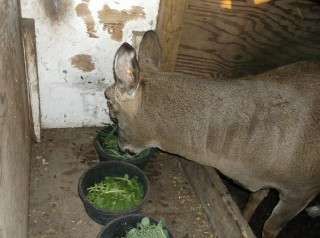Luring deer away from livestock feed with fall cover crops

Fall cover crops, such as clover, turnips and peas, can provide nutrient-rich winter forage and help lure hungry deer away from hay and other stored livestock feed, according to Distinguished Professor Jonathan Jenks of the South Dakota State University Department of Natural Resource Management
The Agricultural Experiment Station researcher and graduate student Troy Wieberg are identifying which cover crops are more likely to attract deer through a three-year grant for nearly $90,000 from the Federal Aid to Wildlife Restoration, administered by South Dakota Department of Game, Fish and Parks. The project, which is in its final year, focuses on eastern South Dakota.
Cover crops, planted in August or September, must have sufficient fall moisture, which made Eastern South Dakota an ideal location for the experiment, according to Kevin Robling, big game biologist for the South Dakota Department of Game, Fish and Parks. In addition, "this area has the potential to experience lots of issues with depredation during severe winters."
Though some landowners have experimented with cover crops, such as turnips, on their own, this is the first controlled experiment, according to Jenks. "We're looking at preference and nutritional characteristics," he pointed out.
Preventing depredation, reducing density
"The leading covariant that will dictate the amount of deer depredation on an annual basis is the severity of the winter," according Robling.
"We're coming off years of peak harvest and peak population," Robling said, noting high deer numbers from 2007 through 2011. However, a combination of factors including liberal antlerless harvest, disease and severe winters has reduced the population below management objectives, he explained.
"We're trying to grow our herds in most management areas with very few units across the state at or above management objectives," Robling said.
The majority of the issues occur when large herds, upward of 100 to 200 individuals, go into yards and eat stored livestock feed, especially hay and distiller grains, according to Robling.
Cover crops are an indirect way of possibly preventing depredation and redistributing deer densities, he explained. Once researchers identify the most palatable forage types, the Department of Game, Fish and Parks may plant crops to attract deer to state-owned lands that are open to public hunting and potentially lure deer away from areas where they may cause problems.
He estimated that no-till drills could handle crops, such as sorghum and rye, and radishes can be sown using a broadcast spreader on the back of four-wheeler and then worked in with a drag.
"We're not talking about large tracts," Robling said, with most cover plots in the range of three to five acres. "Deer are going to go for the candy bar and we're trying to provide that."
Selecting cover crops
For the research project, Jenks and Wieberg planted six cover crops—purple top turnips, Daikon radishes, Austrian winter peas, winter rye, chicory and crimson clover—at the Wildlife and Fisheries Sciences Research Facility. The deer are then allowed to forage on the crops.
Preliminary results showed that turnips and radishes are the top two choices followed by peas, according to Jenks. "These provide high crude protein and moderate to high digestibility."
When the results are compiled, Jenks will give wildlife officials recommendations regarding how cover crops can be used to help manage the state's deer population.
Provided by South Dakota State University



















